Oil Palm and Machine Learning: Reviewing One Decade of Ideas, Innovations, Applications, and Gaps
Abstract
:1. Introduction
2. Background of Oil Palm and Machine Learning
3. Review Scope and Methodology
3.1. Design Phase
3.1.1. Review Topic Selection
3.1.2. Defining Search String
3.1.3. Defining Review Scope and Boundary
3.1.4. Defining Exclusion Criteria
- Exclusion Principle 1—publication that is not related to the agricultural/industrial sector of oil palm with ML application.
- Exclusion Principle 2—publication is written in any language other than English.
- Exclusion Principle 3—publication is already retrieved/is a duplicate.
- Exclusion Principle 4—full text/abstract of the publication is unavailable.
- Exclusion Principle 5—publications that are survey/review articles reviewing old publications.
- Exclusion Principle 6—work that is published before 2011.
- Exclusion Principle 7—publication is published after 2020.
3.1.5. Research Questions
- Q1—what is the annual rate of publications that apply machine learning to oil palm?
- Q2—what are research trends in this domain?
- Q3—which MLAs have been highly used during the previous ten years to serve oil palm?
- Q4—which countries are actively involved in research on the application of machine learning in oil palm?
- Q5—what datasets/sources are used to investigate oil palm with machine learning?
- Q6—what are the key input features preferred by researchers?
- Q7—how are applied algorithms/ models evaluated to guarantee the significance and rationality of the outcomes?
3.2. Implementation Phase
3.2.1. Article Collection
3.2.2. Initial Analysis
3.2.3. Articles Categorization
3.2.4. Detailed Review
3.2.5. Information Extraction and Reporting
4. Results
| Papers Category | Input Features |
|---|---|
| Multipurpose classification | Tree crowns and categorical features; thermal images; quantitative features; climatological features; ratios of kernel to fruit; shell to bunch; shell to fruit; fruit to bunch; messocarp to fruit; oil to dry messocarp, and oil per palm; chlorophyll-sensitive wavelengths; FFB colours; electrical properties of leaves; and levels of potassium (K), nitrogen (N), phosphorus (P), magnesium (Mg), and calcium (Ca) |
| Disease detection | Tree crown size and categorical features, spectral reflectance, and leaves and stem colours |
| Prediction/estimation | Fruit age, plant life, age factor, normalized difference vegetation index (NDVI) average value, daily CPO prices, monthly closing prices of oils, oil palm production, benefits, plant scale index, sex determination, inflorescence abortion, foliar nutrient composition, FFB yield, growth, respiration, and meteorological variables |
| Land cover/tree detection | Positive/negative histogram of oriented gradients (HOG), crown size, images of oil palm, built-up, bare land, water, forest |
| FFB Analysis | Flavonoid, anthocyanin content, fruit colour, fruit size, hue, saturation, intensity, contour lines, blue-to-red fluorescence ratio (BRR_FRF) |
| UAV for canopy monitoring | Tree crown, stems length, tree colours, crown size, bare land, water |
4.1. Multipurpose Classification
| Articles | Dataset | Model/Algorithm(s) | Objective |
|---|---|---|---|
| [44] | Thermal and meteorological dataset, labeled images of area of interest (AOI) | RF, K nearest neighbour (KNN), SVM | Classification of female inflorescences’ anthesis stages in oil palm |
| [41] | Average phenotype | Ridge regression-best linear unbiased prediction (RR_BLUP), Bayes A, Bayes B, Cπ, SVM, ridge regression (RR), RF, least absolute shrinkage and selection operator (LASSO) | Evaluation of marker systems and methods for genomic selection of oil palm |
| [42] | Tree images, leaf spectral reflectance, and fertilizers’ application experiments | Decision tree (DT), RF | Calculation of chlorophyll sufficiency levels in mature palm using hyperspectral remote sensing |
| [43] | Leaf samples, nutrients | Logistic model tree (LMT), naïve Bayes (NB), synthetic minority over-sampling technique (SMOTE), adaptive boosting (AdaBoost) | Oil palm’s macronutrients classification |
| [45] | FFB samples | CART | Fruit ripeness identification |
| [46] | Laboratory measurements | ANN, linear model (LM), gradient descent algorithm (GDA) | Modelling of dielectric properties of oil palm fruitlets |
4.2. Disease Detection
| Articles | Dataset | Model/Algorithm(s) | Objective(s) |
|---|---|---|---|
| [11] | Quickbird imagery | SVM, RF, CART | Modelling of basal stem rot disease |
| [50] | Weather data, infected trees test, spectral reflectance data, detached leaflets from fronds | ANN | Early detection of ganoderma basal stem rot |
| [48] | Impedance, capacitance, dielectric constant, and dissipation factor in infected trees | SVM, RF, and genetic algorithm (GA) (for features selection), ANN, SVM for classification | Spectral features selection and classification of infected oil palm leaves from BSR disease |
| [49] | Disease, symptoms, treatment | NB | The diagnosis of disease in oil palm |
| [47] | Worldview-3 imagery, real time field imagery | DT, RF, SVM | Severity of BSR in oil palm farms |
4.3. UAV for Canopy Monitoring
| Articles | Dataset | Model/Algorithm(s) | Objective(s) |
|---|---|---|---|
| [52] | Images of 2-, 4-, and 7-year-old trees | Linear regression (LR) | Automatic canopy segmentation |
| [53] | Plantation images | Visual geomatry group-single shot detector (VGG-SSD), faster-RCNN, YOLO-V3, Retina-net, Mobilenet-SSD | Fast and robust detection of oil palm |
| [54] | Oil palm images | Histogram of oriented gradients (HOG-SVM), SVM | Detecting Individual oil palm tree |
| [55] | Oil palm images | SVM | Counting oil palm inventory |
| [56] | Oil palm images | CNN | Oil palm tree detection |
4.4. Prediction/Estimation
| Articles | Dataset | Model/Algorithm(s) | Objective(s) |
|---|---|---|---|
| [58] | Field aata, FFB samples | Discriminant analysis (DA), polynomial regression (PR) | Identifying ripeness and forecasting harvest time of oil palm |
| [59] | SPOT6 imagery | ANN, linear regression | Estimation of the amount of oil palm production |
| [60] | CPO historical prices | ANN, autoregressive fractional integral moving average (ARFIMA), adaptive neuro-fuzzy inference system (ANFIS) | Forecasting on crude palm oil prices |
| [61] | CPO historical prices | SVR, holt winter exponential smoothing | Multivariate time series forecasting of crude palm oil price |
| [62] | Time series data | Support vactor regression (SVR), ANN | Prediction of oil palm production |
| [63] | Crop characteristics, climatic data | ECOPALM | Prediction of seasonal variations in FFB production |
| [65] | FFB yield—the foliar nutrient composition | ANN | Modelling Malaysian oil palm yield |
| [64] | Description of water, solar radiation, and nutrients | PALMSIM | Simulating potential growth and yield of oil palm |
| [67] | Soil fertility, water, weather, and historical FFB yield | Bayesian network | Predicting future FFB yield |
| [68] | Region of interest (ROI) images, rule-based expert opinion | Rule-based expert system (RBES), KNN, SVM, ANN | Oil palm FFB ripeness prediction |
4.5. Land Cover/Tree Detection
| Articles | Dataset | Model/ Algorithm(s) | Objective(s) |
|---|---|---|---|
| [74] | GEE Sentinel-1,2 images | DEEPLABV3+ CNN | Worldwide map of oil palm plantations |
| [75] | GEE images | RF | Recording the spatial allocation of oil palm |
| [77] | WorldView-3 | CNN | Detecting young and mature oil palm trees |
| [69] | GEE images | SVM | Monitoring oil palm cultivation monitoring |
| [78] | Images captured at site | Viola and Jones detector | Oil palm map |
| [79] | Calculated biomass values, forest type, and soil information | DA, logarithmic regressions | Estimating aboveground biomass in oil palm plantation |
| [80] | Satellite imagery, time series data from MODIS, field data | Moving average (MA), DT | Detecting land cover conversion to oil palm |
| [10] | Remote sensor images | CNN | Tree detection and counting |
| [81] | Images from Kaggle | DenseNet, DenseNet with saliency and semantic parsing (SSP) | Industrial oil palm monitoring |
| [82] | Earth Explore images | SVM | Oil palm distribution mapping |
| [70] | QuickBird satellite images | Faster-CNN | Detecting oil palm trees |
| [73] | QuickBird satellite images | TS-CNN | Detecting oil palm trees |
| [71] | WorldView-3, LiDAR | SVM, RF | Oil palm tree counting and age estimation |
| [83] | GEE Images, shuttle radar topographic mission (SRTM), NDVI, normalized difference water index (NDWI), digital elevation models (DEM) | SVM, CART, RF | Oil palm mapping |
| [72] | QuickBird imagery | Vegitation indices, semi-variogram computation | Detection of oil palm trees |
| [84] | GEE images | SVM, RF, CART | Monitoring oil palm farms in Malaysia |
| [85] | Land cover map, WorldView-2 image, field data | SVM and maximum likelihood classifier (MLC) | Mapping of oil palm |
| [86] | Site-specific agrometeorological data | Dempster–Shafer Inference | Irrigation management in oil palm crops |
| [87] | Palm trees images | Logistic regression | Validation of an oil palm detection system |
4.6. Fresh Fruit Bunch Analysis
| Articles | Dataset | Model/Algorithm(s) | Objective(s) |
|---|---|---|---|
| [93] | FFB images | LR, ANN, principal component analysis (PCA) | Oil palm fruit grading |
| [95] | FFB images | ANN | FFB ripeness detection |
| [96] | FFB images | SVM, NB | FFB ripeness grading |
| [89] | Fuzzy logic | Rule-based classification | Oil palm fruit grading system |
| [94] | FFB images | Background segmentation, Gaussian filtering | Segmentation of oil palm FFB images |
| [97] | FFB images | DA, ANN, PCA | Features extraction of oil palm FFB |
| [46] | Laboratory measurements | ANN, LM, Gaussian discriminant analysis (GDA) | Modelling of dielectric properties of fruitlets |
| [98] | FFB, flavonoïdes, anthocyanines | CART, ANN, stochastic gradient boosting trees (SGBT) | Determining FFB ripeness |
| [45] | FFB samples | CART | Fruit ripeness identification |
| [99] | FFB images | PCA- ANN | FFB ripeness determination |
| [100] | FFB sample | Oil palm fruit sensor concept | Grading of FFB |
| [101] | Palm fruitlets | Multi ANFIS | Inference system for dielectric properties of FFB |
| [45] | FFB samples | CART | FFB ripeness detection |
| [88] | FFB images | ANN | FFB ripeness detection |
| [102] | FFB images | Back propagation, learning vector quantization | FFB ripeness determination |
| [90] | FFB images | ANN | Fruit grading |
| [103] | FFB images | K mean clustering | FFB growth determination system |
| [104] | Field data | Unified modeling language (UML diagram) | Fruit grading |
| [105] | FFB images | SVM, ANN, ALEXNET | Fruit ripeness grading |
| [106] | FFB images | ANN, KNN, SVM | FFB ripeness grading |
| [92] | FFB acceptance rules, images | Mathematical regression | Grading machine for oil palm FFB |
| [107] | FFB age, maturity, spiral leaf images | Mathematical equations | FFB maturity stages determination |
| [68] | Region of interest (ROI) images, rule-based expert opinion | Rule-based expert system (RBES), KNN, SVM, ANN | FFB ripeness determination |
5. Discussion
5.1. Results-Based Discussion
5.2. General Discussion
5.3. Search-Based Discussion
5.4. Analysis Based Discussion
5.5. Research Questions Based Discussion
5.6. Challenges-Based Discussion
6. Conclusions
Funding
Acknowledgments
Conflicts of Interest
Nomenclature
| General abbreviations | Abbreviations for machine learning models | ||
| ML | Machine learning | LM | Linear model |
| DL | Deep learning | VGG-SSD | Visual geometry group-single shot detector |
| MLA | Machine learning algorithm | HOG | Histogram of oriented gradients |
| AI | Artificial ontelligence | LMT | Logistic model tree |
| RGB | Red-green-blue | ARFIMA | Autoregressive fractional integral moving average |
| CPO | Crude palm oil | ANFIS | Adaptive neuro-fuzzy inference system |
| FFB | Fresh fruit bunch | SGBT | Stochastic gradient boosting trees (SGBT) |
| RBES | Rule-based expert system | GANN | Genetic algorithm neural network |
| G. boninense | Ganoderma boninense | BLUP | Best linear unbiased prediction |
| UML | Unified modeling language | Abbreviations for model performance evaluation metrics | |
| SLR | Systematic literature review | OA | Overall accuracy |
| UAV | Unmanned aerial vehicle | PA | Prediction accuracy |
| GEE | Google Earth engine | UA | User accuracy |
| DBMS | Data base management system | CA | Classification accuracy |
| GS | Genome selection | RMSE | Root mean squared error |
| BSR | Basal stem rot | R2 | R squared (coefficient of determination) |
| MAE | Mean absolute error | ||
| OER | Oil extraction ratio | DA | Detection accuracy |
| Abbreviations for machine learning techniques and algorithms | |||
| SVM | Support vector machine | RR | Ridge regression |
| KNN | K-nearest neighbor | DT | Decision tree |
| ANN | Artificial neural network | MA | Moving average |
| CNN | Convolutional neural network | GDA | Gradient descent algorithm |
| CART | Classification and regression tree | LASSO | Least absolute shrinkage and selection operator |
| RF | Random forest | NB | Naïve Bayes |
| RFT | Random forest tree | ||
| DA | Discriminant analysis | SMOTE | Synthetic minority over-sampling technique |
| LR | Logistic regression | AdaBoost | Adaptive boosting |
| DT | Decision tree | GA | Genetic algorithm |
| MA | Moving average | PR | Polynomial regression |
| GDA | Gradient descent algorithm | SVR | Support vector regression |
| RR | Ridge regression | PCA | Principal component analysis |
| GA | Genetic algorithm | JNB | Jenks natural breaks |
| MLC | Maximum likelihood classifier | GDA | Gaussian discriminant analysis |
References
- Singh, D.; Sharma, D.; Soni, S.L.; Inda, C.S.; Sharma, S.; Sharma, P.K.; Jhalani, A. A Comprehensive Review on 1st-Generation Biodiesel Feedstock Palm Oil: Production, Engine Performance, and Exhaust Emissions. BioEnergy Res. 2020, 14, 1–22. [Google Scholar] [CrossRef]
- Corley, R. How much palm oil do we need? Environ. Sci. Policy 2009, 12, 134–139. [Google Scholar] [CrossRef]
- Ming, K.K.; Chandramohan, D. Malaysian palm oil industry at crossroads and its future direction. Oil Palm Ind. Econ. J. 2002, 2, 10–15. [Google Scholar]
- Barcelos, E.; Rios, S.D.A.; Cunha, R.N.; Lopes, R.; Motoike, S.Y.; Babiychuk, E.; Skirycz, A.; Kushnir, S. Oil palm natural diversity and the potential for yield improvement. Front. Plant Sci. 2015, 6, 190. [Google Scholar] [CrossRef]
- Kushairi, A.; Singh, R.; Ong-Abdullah, M. The oil palm industry in Malaysia: Thriving with transformative technologies. J. Oil Palm Res. 2017, 29, 431–439. [Google Scholar]
- Rahman, S.A.Z.; Mitra, K.C.; Islam, S.M. Soil classification using machine learning methods and crop suggestion based on soil series. In Proceedings of the 2018 21st International Conference of Computer and Information Technology (ICCIT), Dhaka, Bangladesh, 21–23 December 2018. [Google Scholar]
- Chlingaryan, A.; Sukkarieh, S.; Whelan, B. Machine learning approaches for crop yield prediction and nitrogen status estimation in precision agriculture: A review. Comput. Electron. Agric. 2018, 151, 61–69. [Google Scholar] [CrossRef]
- Dimitriadis, S.; Goumopoulos, C. Applying machine learning to extract new knowledge in precision agriculture applications. In Proceedings of the 2008 Panhellenic Conference on Informatics, Samos, Greece, 28–30 August 2008. [Google Scholar]
- Behmann, J.; Mahlein, A.K.; Rumpf, T.; Römer, C.; Plümer, L. A review of advanced machine learning methods for the detection of biotic stress in precision crop protection. Precis. Agric. 2015, 16, 239–260. [Google Scholar] [CrossRef]
- Li, W.; Fu, H.; Yu, L.; Cracknell, A. Deep learning based oil palm tree detection and counting for high-resolution remote sensing images. Remote Sens. 2017, 9, 22. [Google Scholar] [CrossRef] [Green Version]
- Santoso, H.; Tani, H.; Wang, X. Random Forest classification model of basal stem rot disease caused by Ganoderma boninense in oil palm plantations. Int. J. Remote Sens. 2017, 38, 4683–4699. [Google Scholar] [CrossRef]
- Van Dijk, M.; Morley, T.; Jongeneel, R.; van Ittersum, M.; Reidsma, P.; Ruben, R. Disentangling agronomic and economic yield gaps: An integrated framework and application. Agric. Syst. 2017, 154, 90–99. [Google Scholar] [CrossRef]
- Cintra, M.E.; Meira, C.A.; Monard, M.C.; Camargo, H.A.; Rodrigues, L.H. The use of fuzzy decision trees for coffee rust warning in Brazilian crops. In Proceedings of the 2011 11th International Conference on Intelligent Systems Design and Applications, Cordoba, Spain, 22–24 November 2011. [Google Scholar]
- Fan, J.; Wu, L.; Zhang, F.; Cai, H.; Zeng, W.; Wang, X.; Zou, H. Empirical and machine learning models for predicting daily global solar radiation from sunshine duration: A review and case study in China. Renew. Sustain. Energy Rev. 2019, 100, 186–212. [Google Scholar] [CrossRef]
- Föhse, D.; Claassen, N.; Jungk, A. Phosphorus efficiency of plants. Plant Soil 1988, 110, 101–109. [Google Scholar] [CrossRef]
- Kaiser, E.-A.; Kohrs, K.; Kücke, M.; Schnug, E.; Heinemeyer, O.; Munch, J.C. Nitrous oxide release from arable soil: Importance of N-fertilization, crops and temporal variation. Soil Biol. Biochem. 1998, 30, 1553–1563. [Google Scholar] [CrossRef]
- Cogato, A.; Meggio, F.; De Antoni Migliorati, M.; Marinello, F. Extreme weather events in agriculture: A systematic review. Sustainability 2019, 11, 2547. [Google Scholar] [CrossRef] [Green Version]
- Paul, J.; Criado, A.R. The art of writing literature review: What do we know and what do we need to know? Int. Bus. Rev. 2020, 29, 101717. [Google Scholar] [CrossRef]
- Chong, K.L.; Kanniah, K.D.; Pohl, C.; Tan, K.P. A review of remote sensing applications for oil palm studies. Geo-Spat. Inf. Sci. 2017, 20, 184–200. [Google Scholar] [CrossRef] [Green Version]
- Kurnia, J.C.; Jangam, S.V.; Akhtar, S.; Sasmito, A.P.; Mujumdar, A.S. Advances in biofuel production from oil palm and palm oil processing wastes: A review. Biofuel Res. J. 2016, 3, 332–346. [Google Scholar] [CrossRef]
- Barbedo, J.G.A. Detection of nutrition deficiencies in plants using proximal images and machine learning: A review. Comput. Electron. Agric. 2019, 162, 482–492. [Google Scholar] [CrossRef]
- Khosrokhani, M.; Khairunniza-Bejo, S.; Pradhan, B. Geospatial technologies for detection and monitoring of Ganoderma basal stem rot infection in oil palm plantations: A review on sensors and techniques. Geocarto Int. 2018, 33, 260–276. [Google Scholar] [CrossRef]
- Pandey, R.; Naik, S.; Marfatia, R. Image processing and machine learning for automated fruit grading system: A technical review. Int. J. Comput. Appl. 2013, 81, 29–39. [Google Scholar] [CrossRef]
- Rashid, M.; Bari, B.S.; Yusup, Y.; Kamaruddin, M.A.; Khan, N. A Comprehensive Review of Crop Yield Prediction Using Machine Learning Approaches with Special Emphasis on Palm Oil Yield Prediction. IEEE Access 2021, 9, 63406–63439. [Google Scholar] [CrossRef]
- Uning, R.; Latif, M.T.; Othman, M.; Juneng, L.; Mohd Hanif, N.; Nadzir, M.S.M.; Maulud, K.N.A.; Jaafar, W.S.W.M.; Said, N.T.S.; Ahamad, F.; et al. A review of Southeast Asian oil palm and Its CO2 fluxes. Sustainability 2020, 12, 5077. [Google Scholar] [CrossRef]
- Von Uexkull, H.; Fairhurst, T. Oil Palm; International Potash Institute: Singapore, Singapore, 1992. [Google Scholar]
- Sutherland, S. What makes a weed a weed: Life history traits of native and exotic plants in the USA. Oecologia 2004, 141, 24–39. [Google Scholar] [CrossRef] [PubMed]
- Legros, S.; Mialet-Serra, I.; Caliman, J.P.; Siregar, F.A.; Clément-Vidal, A.; Fabre, D.; Dingkuhn, M. Phenology, growth and physiological adjustments of oil palm (Elaeis guineensis) to sink limitation induced by fruit pruning. Ann. Bot. 2009, 104, 1183–1194. [Google Scholar] [CrossRef] [Green Version]
- Ismail, A.; Mamat, M.N. The optimal age of oil palm replanting. Oil Palm Ind. Econ. J. 2002, 2, 11–18. [Google Scholar]
- Jelsma, I.; Woittiez, L.S.; Ollivier, J.; Dharmawan, A.H. Do wealthy farmers implement better agricultural practices? An assessment of implementation of Good Agricultural Practices among different types of independent oil palm smallholders in Riau, Indonesia. Agric. Syst. 2019, 170, 63–76. [Google Scholar] [CrossRef]
- Gérard, A.; Wollni, M.; Hölscher, D.; Irawan, B.; Sundawati, L.; Teuscher, M.; Kreft, H. Oil-palm yields in diversified plantations: Initial results from a biodiversity enrichment experiment in Sumatra, Indonesia. Agric. Ecosyst. Environ. 2017, 240, 253–260. [Google Scholar] [CrossRef]
- Rhebergen, T.; Zingore, S.; Giller, K.E.; Frimpong, C.A.; Acheampong, K.; Ohipeni, F.T.; Panyin, E.K.; Zutah, V.; Fairhurst, T. Closing yield gaps in oil palm production systems in Ghana through Best Management Practices. Eur. J. Agron. 2020, 115, 126011. [Google Scholar] [CrossRef]
- Alpaydin, E. Introduction to Machine Learning; The MIT Press: Cambridge, MA, USA, 2010. [Google Scholar]
- Sacchelli, S.; Fabbrizzi, S.; Menghini, S. Climate change effects and adaptation strategies in the wine sector: A quantitative literature review. Wine Econ. Policy 2016, 5, 114–126. [Google Scholar] [CrossRef] [Green Version]
- Butler, A.; Hall, H.; Copnell, B. A guide to writing a qualitative systematic review protocol to enhance evidence-based practice in nursing and health care. Worldviews Evid.-Based Nurs. 2016, 13, 241–249. [Google Scholar] [CrossRef] [PubMed]
- Fakis, A.; Hilliam, R.; Stoneley, H.; Townend, M. Quantitative analysis of qualitative information from interviews: A systematic literature review. J. Mix. Methods Res. 2014, 8, 139–161. [Google Scholar] [CrossRef]
- Shamseer, L.; Moher, D.; Clarke, M.; Ghersi, D.; Liberati, A.; Petticrew, M.; Shekelle, P.; Stewart, L.A. Preferred reporting items for systematic review and meta-analysis protocols (PRISMA-P) 2015: Elaboration and explanation. Br. Med. J. 2015, 349. [Google Scholar] [CrossRef] [PubMed] [Green Version]
- Teng, S.; Khong, K.W.; Ha, N.C. Palm oil and its environmental impacts: A big data analytics study. J. Clean. Prod. 2020, 274, 122901. [Google Scholar] [CrossRef]
- Moher, D.; Liberati, A.; Tetzlaff, J.; Altman, D.G.; Prisma Group. Preferred reporting items for systematic reviews and meta-analyses: The PRISMA statement. PLoS Med. 2009, 6, e1000097. [Google Scholar] [CrossRef] [Green Version]
- Van Klompenburg, T.; Kassahun, A.; Catal, C. Crop yield prediction using machine learning: A systematic literature review. Comput. Electron. Agric. 2020, 177, 105709. [Google Scholar] [CrossRef]
- Kwong, Q.B.; Teh, C.K.; Ong, A.L.; Chew, F.T.; Mayes, S.; Kulaveerasingam, H.; Tammi, M.; Yeoh, S.H.; Appleton, D.R.; Harikrishna, J.A. Evaluation of methods and marker Systems in Genomic Selection of oil palm (Elaeis guineensis Jacq.). BMC Genet. 2017, 18, 107. [Google Scholar] [CrossRef] [PubMed] [Green Version]
- Amirruddin, A.D.; Muharam, F.M.; Ismail, M.H.; Ismail, M.F.; Tan, N.P.; Karam, D.S. Hyperspectral remote sensing for assessment of chlorophyll sufficiency levels in mature oil palm (Elaeis guineensis) based on frond numbers: Analysis of decision tree and random forest. Comput. Electron. Agric. 2020, 169, 105221. [Google Scholar] [CrossRef]
- Amirruddin, A.D.; Muharam, F.M.; Ismail, M.H.; Tan, N.P.; Ismail, M.F. Hyperspectral spectroscopy and imbalance data approaches for classification of oil palm’s macronutrients observed from frond 9 and 17. Comput. Electron. Agric. 2020, 178, 105768. [Google Scholar] [CrossRef]
- DB, M.Y.; Rafie, A.M.; Abd Aziz, S.; Azrad, S.; Masri, M.M.M.; Shahi, A.; Marzuki, O.F. Classification of oil palm female inflorescences anthesis stages using machine learning approaches. Inf. Process. Agric. 2020. [CrossRef]
- H azir, M.H.M.; Shariff, A.R.M.; Amiruddin, M.D.; Ramli, A.R.; Saripan, M.I. Oil palm bunch ripeness classification using fluorescence technique. J. Food Eng. 2012, 113, 534–540. [Google Scholar] [CrossRef]
- A dedayo, O.O.; Isa, M.; Che, S.A.; Abbas, Z. Comparison of Feed Forward Neural Network Training Algorithms for Intelligent Modeling of Dielectric Properties of Oil Palm Fruitlets. Int. J. Eng. Adv. Technol. (IJEAT) 2014, 3, 38–42. [Google Scholar]
- Santoso, H.; Tani, H.; Wang, X.; Prasetyo, A.E.; Sonobe, R. Classifying the severity of basal stem rot disease in oil palm plantations using WorldView-3 imagery and machine learning algorithms. Int. J. Remote Sens. 2019, 40, 7624–7646. [Google Scholar] [CrossRef]
- Khaled, A.Y.; Abd Aziz, S.; Bejo, S.K.; Nawi, N.M.; Seman, I.A. Spectral features selection and classification of oil palm leaves infected by Basal stem rot (BSR) disease using dielectric spectroscopy. Comput. Electron. Agric. 2018, 144, 297–309. [Google Scholar] [CrossRef]
- Nababan, M.; Laia, Y.; Sitanggang, D.; Sihombing, O.; Indra, E.; Siregar, S.; Purba, W.; Mancur, R. The diagnose of oil palm disease using Naive Bayes Method based on Expert System Technology. J. Phys. Conf. Ser. 2018, 1007, 012015. [Google Scholar] [CrossRef]
- Ahmadi, P.; Muharam, F.M.; Ahmad, K.; Mansor, S.; Seman, I.A. Early detection of Ganoderma basal stem rot of oil palms using artificial neural network spectral analysis. Plant Dis. 2017, 101, 1009–1016. [Google Scholar] [CrossRef] [PubMed] [Green Version]
- Hunt, E.R.; Hively, W.D.; Fujikawa, S.J.; Linden, D.S.; Daughtry, C.S.; McCarty, G.W. Acquisition of NIR-green-blue digital photographs from unmanned aircraft for crop monitoring. Remote Sens. 2010, 2, 290–305. [Google Scholar] [CrossRef] [Green Version]
- Fawcett, D.; Azlan, B.; Hill, T.C.; Kho, L.K.; Bennie, J.; Anderson, K. Unmanned aerial vehicle (UAV) derived structure-from-motion photogrammetry point clouds for oil palm (Elaeis guineensis) canopy segmentation and height estimation. Int. J. Remote Sens. 2019, 40, 7538–7560. [Google Scholar] [CrossRef] [Green Version]
- Xia, M.; Li, W.; Fu, H.; Yu, L.; Dong, R.; Zheng, J. Fast and robust detection of oil palm trees using high-resolution remote sensing images. In Automatic Target Recognition XXIX; International Society for Optics and Photonics: Baltimore, MD, USA, 2019. [Google Scholar] [CrossRef]
- Wang, Y.; Zhu, X.; Wu, B. Automatic detection of individual oil palm trees from UAV images using HOG features and an SVM classifier. Int. J. Remote Sens. 2019, 40, 7356–7370. [Google Scholar] [CrossRef]
- Kalantar, B.; Idrees, M.O.; Mansor, S.; Halin, A.A. Smart counting—Oil palm tree inventory with UAV. Coordinates 2017, 13, 17–22. [Google Scholar]
- Zortea, M.; Nery, M.; Ruga, B.; Carvalho, L.B.; Bastos, A.C. Oil-palm tree detection in aerial images combining deep learning classifiers. In Proceedings of the IGARSS 2018-2018 IEEE International Geoscience and Remote Sensing Symposium, Valencia, Spain, 22–27 July 2018. [Google Scholar]
- Khaki, S.; Wang, L.; Archontoulis, S.V. A cnn-rnn framework for crop yield prediction. Front. Plant Sci. 2020, 10, 1750. [Google Scholar] [CrossRef]
- Sinambela, R.; Mandang, T.; Subrata, I.D.M.; Hermawan, W. Application of an inductive sensor system for identifying ripeness and forecasting harvest time of oil palm. Sci. Hortic. 2020, 265, 109231. [Google Scholar] [CrossRef]
- Diana, S.R.; Purnama, S.M.; Dharma, G.; Sutrisnanto, A.; Perwitasari, I.; Farida, F. Estimation the Amount of Oil Palm Production Using Artificial Neural Network and NDVI SPOT-6 Imagery. Int. J. Innov. Sci. Res. Technol. 2019, 4, 548–554. [Google Scholar]
- Karia, A.A.; Bujang, I.; Ahmad, I. Forecasting on crude palm oil prices using artificial intelligence approaches. Am. J. Oper. Res. 2013, 3, 29230. [Google Scholar] [CrossRef] [Green Version]
- Kanchymalay, K.; Salim, N.; Sukprasert, A.; Krishnan, R.; Hashim, U.R.A. Multivariate time series forecasting of crude palm oil price using machine learning techniques. IOP Conf. Ser.: Mater. Sci. Eng. 2017, 226, 012117. [Google Scholar] [CrossRef]
- Mustakim, M.; Buono, A.; Hermadi, I. Performance comparison between support vector regression and artificial neural network for prediction of oil palm production. J. Ilmu Komput. Dan Inf. 2016, 9, 1–8. [Google Scholar]
- Combres, J.-C.; Pallas, B.; Rouan, L.; Mialet-Serra, I.; Caliman, J.-P.; Braconnier, S.; Soulié, J.-C.; Dingkuhn, M. Simulation of inflorescence dynamics in oil palm and estimation of environment-sensitive phenological phases: A model based analysis. Funct. Plant Biol. 2013, 40, 263–279. [Google Scholar] [CrossRef]
- Hoffmann, M.P.; Vera, A.C.; Van Wijk, M.T.; Giller, K.E.; Oberthür, T.; Donough, C.; Whitbread, A.M. Simulating potential growth and yield of oil palm (Elaeis guineensis) with PALMSIM: Model description, evaluation and application. Agric. Syst. 2014, 131, 1–10. [Google Scholar] [CrossRef] [Green Version]
- Zuhaimy, I.; Azme, K. Neural network in modeling Malaysian oil palm yield. Am. J. Appl. Sci. 2011, 8, 796–803. [Google Scholar]
- Oettli, P.; Behera, S.K.; Yamagata, T. Climate based predictability of oil palm tree yield in Malaysia. Sci. Rep. 2018, 8, 2271. [Google Scholar] [CrossRef] [Green Version]
- Chapman, R.; Cook, S.; Donough, C.; Lim, Y.L.; Ho, P.V.V.; Lo, K.W.; Oberthür, T. Using Bayesian networks to predict future yield functions with data from commercial oil palm plantations: A proof of concept analysis. Comput. Electron. Agric. 2018, 151, 338–348. [Google Scholar] [CrossRef]
- Alfatni, M.S.M.; Shariff, A.R.M.; Abdullah, M.Z.; Marhaban, M.H.; Shafie, S.B.; Bamiruddin, M.D.; Saaed, O.M.B. Oil palm fresh fruit bunch ripeness classification based on rule-based expert system of ROI image processing technique results. IOP Conf. Ser. Earth Environ. Sci. 2014, 20, 012018. [Google Scholar] [CrossRef]
- Okoro, S.U.; Schickhoff, U.; Böhner, J.; Schneider, U.A. A novel approach in monitoring land-cover change in the tropics: Oil palm cultivation in the Niger Delta, Nigeria. DIE ERDE–J. Geogr. Soc. Berl. 2016, 147, 40–52. [Google Scholar]
- Zheng, J.; Li, W.; Xia, M.; Dong, R.; Fu, H.; Yuan, S. Large-scale oil palm tree detection from high-resolution remote sensing images using faster-rcnn. In Proceedings of the IGARSS 2019, 2019 IEEE International Geoscience and Remote Sensing Symposium, Yokohama, Japan, 28 July–2 August 2019. [Google Scholar]
- Rizeei, H.M.; Shafri, H.Z.; Mohamoud, M.A.; Pradhan, B.; Kalantar, B. Oil palm counting and age estimation from WorldView-3 imagery and LiDAR data using an integrated OBIA height model and regression analysis. J. Sens. 2018, 2018, 2536327. [Google Scholar] [CrossRef] [Green Version]
- Srestasathiern, P.; Rakwatin, P. Oil palm tree detection with high resolution multi-spectral satellite imagery. Remote Sens. 2014, 6, 9749–9774. [Google Scholar] [CrossRef] [Green Version]
- Li, W.; Dong, R.; Fu, H.; Yu, L. Large-scale oil palm tree detection from high-resolution satellite images using two-stage convolutional neural networks. Remote Sens. 2019, 11, 11. [Google Scholar] [CrossRef] [Green Version]
- Descals, A.; Wich, S.; Meijaard, E.; Gaveau, D.L.; Peedell, S.; Szantoi, Z. High-resolution global map of smallholder and industrial closed-canopy oil palm plantations. Earth Syst. Sci. Data Discuss. 2020, 1–22. [Google Scholar] [CrossRef]
- Shaharum, N.S.N.; Shafri, H.Z.M.; Ghani, W.A.W.A.K.; Samsatli, S.; Prince, H.M.; Yusuf, B.; Hamud, A.M. Mapping the spatial distribution and changes of oil palm land cover using an open source cloud-based mapping platform. Int. J. Remote Sens. 2019, 40, 7459–7476. [Google Scholar] [CrossRef]
- M athew, L.S.; Spannagl, M.; Al-Malki, A.; George, B.; Torres, M.F.; Al-Dous, E.K.; Al-Azwani, E.K.; Hussein, E.; Mathew, S.; Mayer, K.F. A first genetic map of date palm (Phoenix dactylifera) reveals long-range genome structure conservation in the palms. BMC Genom. 2014, 15, 1–10. [Google Scholar]
- Mubin, N.A.; Nadarajoo, E.; Shafri, H.Z.M.; Hamedianfar, A. Young and mature oil palm tree detection and counting using convolutional neural network deep learning method. Int. J. Remote Sens. 2019, 40, 7500–7515. [Google Scholar] [CrossRef]
- Juman, M.A.; Wong, Y.W.; Rajkumar, R.K.; Goh, L.J. A novel tree trunk detection method for oil-palm plantation navigation. Comput. Electron. Agric. 2016, 128, 172–180. [Google Scholar] [CrossRef]
- Morel, A.C.; Saatchi, S.S.; Malhi, Y.; Berry, N.J.; Banin, L.; Burslem, D.; Nilus, R.; Ong, R.C. Estimating aboveground biomass in forest and oil palm plantation in Sabah, Malaysian Borneo using ALOS PALSAR data. For. Ecol. Manag. 2011, 262, 1786–1798. [Google Scholar] [CrossRef]
- Gutiérrez-Vélez, V.H.; DeFries, R. Annual multi-resolution detection of land cover conversion to oil palm in the Peruvian Amazon. Remote Sens. Environ. 2013, 129, 154–167. [Google Scholar] [CrossRef]
- Abdani, S.R.; Zulkifley, M.A. Densenet with spatial pyramid pooling for industrial oil palm plantation detection. In Proceedings of the 2019 International Conference on Mechatronics, Robotics and Systems Engineering (MoRSE), Bali, Indonesia, 4–6 December 2019. [Google Scholar]
- Shaharum, N.S.N.; Shafri, H.Z.M.; Ghani, W.A.W.A.K.; Samsatli, S.; Yusuf, B.; Al-Habshi, M.M.A.; Prince, H.M. Image classification for mapping oil palm distribution via support vector machine using Scikit-learn module. Int. Arch. Photogramm. Remote Sens. Spat. Inf. Sci. 2018, 42, 133–137. [Google Scholar] [CrossRef] [Green Version]
- Shaharum, N.S.N.; Shafri, H.Z.M.; Ghani, W.A.W.A.K.; Samsatli, S.; Al-Habshi, M.M.A.; Yusuf, B. Oil palm mapping over Peninsular Malaysia using Google Earth Engine and machine learning algorithms. Remote Sens. Appl. Soc. Environ. 2020, 17, 100287. [Google Scholar] [CrossRef]
- Li, W.; Fu, D.; Su, F.; Xiao, Y. Spatial–Temporal Evolution and Analysis of the Driving Force of Oil Palm Patterns in Malaysia from 2000 to 2018. ISPRS Int. J. Geo-Inf. 2020, 9, 280. [Google Scholar] [CrossRef]
- Nooni, I.K.; Duker, A.A.; Van Duren, I.; Addae-Wireko, L.; Osei Jnr, E.M. Support vector machine to map oil palm in a heterogeneous environment. Int. J. Remote Sens. 2014, 35, 4778–4794. [Google Scholar] [CrossRef]
- Culman, M.; de Farias, C.M.; Bayona, C.; Cruz, J.D.C. Using agrometeorological data to assist irrigation management in oil palm crops: A decision support method and results from crop model simulation. Agric. Water Manag. 2019, 213, 1047–1062. [Google Scholar] [CrossRef]
- Rueda, C.; Miserque, J.; Laverde, R. Validation of an oil-palm detection system based on a logistic regression model. In Proceedings of the 2016 IEEE ANDESCON, Arequipa, Peru, 19–21 October 2016. [Google Scholar]
- Fadilah, N.; Saleh, J.M.; Ibrahim, H.; Halim, Z.A. Oil palm fresh fruit bunch ripeness classification using artificial neural network. In Proceedings of the 2012 4th International Conference on Intelligent and Advanced Systems (ICIAS2012), Kuala Lumpur, Malaysia, 12–14 June 2012. [Google Scholar]
- May, Z.; Amaran, M. Automated oil palm fruit grading system using artificial intelligence. Int. J. Eng. Sci. 2011, 11, 30–35. [Google Scholar]
- Bensaeed, O.M.; Shariff, A.M.; Mahmud, A.B.; Shafri, H.; Alfatni, M. Oil palm fruit grading using a hyperspectral device and machine learning algorithm. IOP Conf. Ser. Earth Environ. Sci. 2014, 20, 012017. [Google Scholar] [CrossRef]
- Makky, M.; Soni, P. Development of an automatic grading machine for oil palm fresh fruits bunches (FFBs) based on machine vision. Comput. Electron. Agric. 2013, 93, 129–139. [Google Scholar] [CrossRef]
- Albakri, Z.M.; Kassim, M.S.M.; Abdullah, A.F.; Harith, H.H. Analysis of Oil Palm Leaf Phyllotaxis towards Development of Models to Determine the Fresh Fruit Bunch (FFB) Maturity Stages, Yield and Site-Specifc Harvesting. Pertanika J. Sci. Technol. 2019, 27, 659–672. [Google Scholar]
- Taparugssanagorn, A.; Siwamogsatham, S.; Pomalaza-Ráez, C. A non-destructive oil palm ripeness recognition system using relative entropy. Comput. Electron. Agric. 2015, 118, 340–349. [Google Scholar] [CrossRef]
- Septiarini, A.; Hamdani, H.; Hatta, H.R.; Anwar, K. Automatic image segmentation of oil palm fruits by applying the contour-based approach. Sci. Hortic. 2020, 261, 108939. [Google Scholar] [CrossRef]
- Shabdin, M.K.; Shariff, A.R.M.; Johari, M.N.A.; Saat, N.K.; Abbas, Z. A study on the oil palm fresh fruit bunch (FFB) ripeness detection by using Hue, Saturation and Intensity (HSI) approach. IOP Conf. Ser. Earth Environ. Sci. 2016, 37, 12039. [Google Scholar] [CrossRef]
- Sabri, N.; Ibrahim, Z.; Syahlan, S.; Jamil, N.; Mangshor, N.N.A. Palm oil fresh fruit bunch ripeness grading identification using color features. J. Fundam. Appl. Sci. 2017, 9, 563–579. [Google Scholar] [CrossRef] [Green Version]
- Fadilah, N.; Mohamad-Saleh, J. Color feature extraction of oil palm fresh fruit bunch image for ripeness classification. In Proceedings of the 13th International Conference on Applied Computer Science 2014, Kualalampur, Malaysia, 23–25 April 2014; pp. 51–55. [Google Scholar]
- Hazir, M.H.M.; Shariff, A.R.M.; Amiruddin, M.D. Determination of oil palm fresh fruit bunch ripeness—Based on flavonoids and anthocyanin content. Ind. Crops Prod. 2012, 36, 466–475. [Google Scholar] [CrossRef]
- Fadilah, N.; Mohamad-Saleh, J.; Abdul Halim, Z.; Ibrahim, H.; Ali, S.S.S. Intelligent color vision system for ripeness classification of oil palm fresh fruit bunch. Sensors 2012, 12, 14179–14195. [Google Scholar] [CrossRef]
- Harun, N.H.; Misron, N.; Sidek, R.M.; Aris, I.; Ahmad, D.; Wakiwaka, H.; Tashiro, K. Investigations on a novel inductive concept frequency technique for the grading of oil palm fresh fruit bunches. Sensors 2013, 13, 2254–2266. [Google Scholar] [CrossRef]
- Adedayo, O.O.; Isa, M.M.; Soh, A.C.; Abbas, Z. Multi-adaptive neuro-fuzzy inference system for dielectric properties of oil palm fruitlets. Int. J. Appl. Sci. Eng. 2014, 12, 1–8. [Google Scholar]
- Fahmi, F.; Suherman, S. Oil palm fresh fruit bunch ripeness classification using back propagation and learning vector quantization. IOP Conf. Ser. Mater. Sci. Eng. 2018, 434, 12066. [Google Scholar] [CrossRef]
- Kassim, M.S.M.; Ismail, W.I.W.; Ramli, A.R.; Bejo, S.K. Oil palm fresh fruit bunches (FFB) growth determination system to support harvesting operation. J. Food Agric. Environ. 2012, 10, 620–625. [Google Scholar]
- Patkar, G.; Anjaneyulu, G.S.G.N.; Mouli, P.C. Palm fruit harvester algorithm for elaeis guineensis oil palm fruit grading using UML. In Proceedings of the 2015 IEEE International Conference on Computational Intelligence and Computing Research (ICCIC), Madurai, India, 10–12 December 2015. [Google Scholar]
- Ibrahim, Z.; Sabri, N.; Isa, D. Palm oil fresh fruit bunch ripeness grading recognition using convolutional neural network. J. Telecommun. Electron. Comput. Eng. (JTEC) 2018, 10, 109–113. [Google Scholar]
- Alfatni, M.S.M.; Shariff, A.R.M.; Bejo, S.K.; Saaed, O.M.B.; Mustapha, A. Real-time oil palm FFB ripeness grading system based on ANN, KNN and SVM classifiers. IOP Conf. Ser. Earth Environ. Sci. 2018, 169, 012067. [Google Scholar] [CrossRef]
- Silalahi, D.D.; Reaño, C.E.; Lansigan, F.P.; Panopio, R.G.; Bantayan, N.C. Using genetic algorithm neural network on near infrared spectral data for ripeness grading of oil palm (Elaeis guineensis Jacq. ) fresh fruit. Inf. Process. Agric. 2016, 3, 252–261. [Google Scholar] [CrossRef] [Green Version]
- Ahirwal, M.K.; Kumar, A.; Singh, G.K. Prediction and Classification. In Computational Intelligence and Biomedical Signal Processing; Springer: Cham, Germany, 2021; pp. 83–111. [Google Scholar] [CrossRef]
- Braga-Neto, U. Fundamentals of Pattern Recognition and Machine Learning; Springer: Cham, Germany, 2020. [Google Scholar] [CrossRef]
- Saiz-Rubio, V.; Rovira-Más, F. From smart farming towards agriculture 5.0: A review on crop data management. Agronomy 2020, 10, 207. [Google Scholar] [CrossRef] [Green Version]
- Saritas, M.M.; Yasar, A. Performance analysis of ANN and Naive Bayes classification algorithm for data classification. Int. J. Intell. Syst. Appl. Eng. 2019, 7, 88–91. [Google Scholar] [CrossRef] [Green Version]
- Soh, A.C.; Mayes, S.; Roberts, J.; Rajanaidu, N.; Din, A.M.; Marhalil, M.; Norziha, A.; Meilina, O.-A.; Fadila, A.M.; Azwani, A.B.N.; et al. Genetic Resources. In Oil Palm Breeding: Genetics and Genomics; CRC Press: Boca Raton, FL, USA, 2017; pp. 19–56. [Google Scholar]
- Rethinam, P.; Murugesan, P. Global perspective of germplasm and breeding for seed production in oil palm. Int. J. Oil Palm 2018, 10, 17–34. [Google Scholar]
- Feldt, R.; Magazinius, A. Validity threats in empirical software engineering research—An initial survey. In Proceedings of the 22nd International Conference on Software Engineering & Knowledge Engineering (SEKE’2010), Redwood City, San Francisco Bay, CA, USA, 1–3 July 2010; pp. 374–379. [Google Scholar]
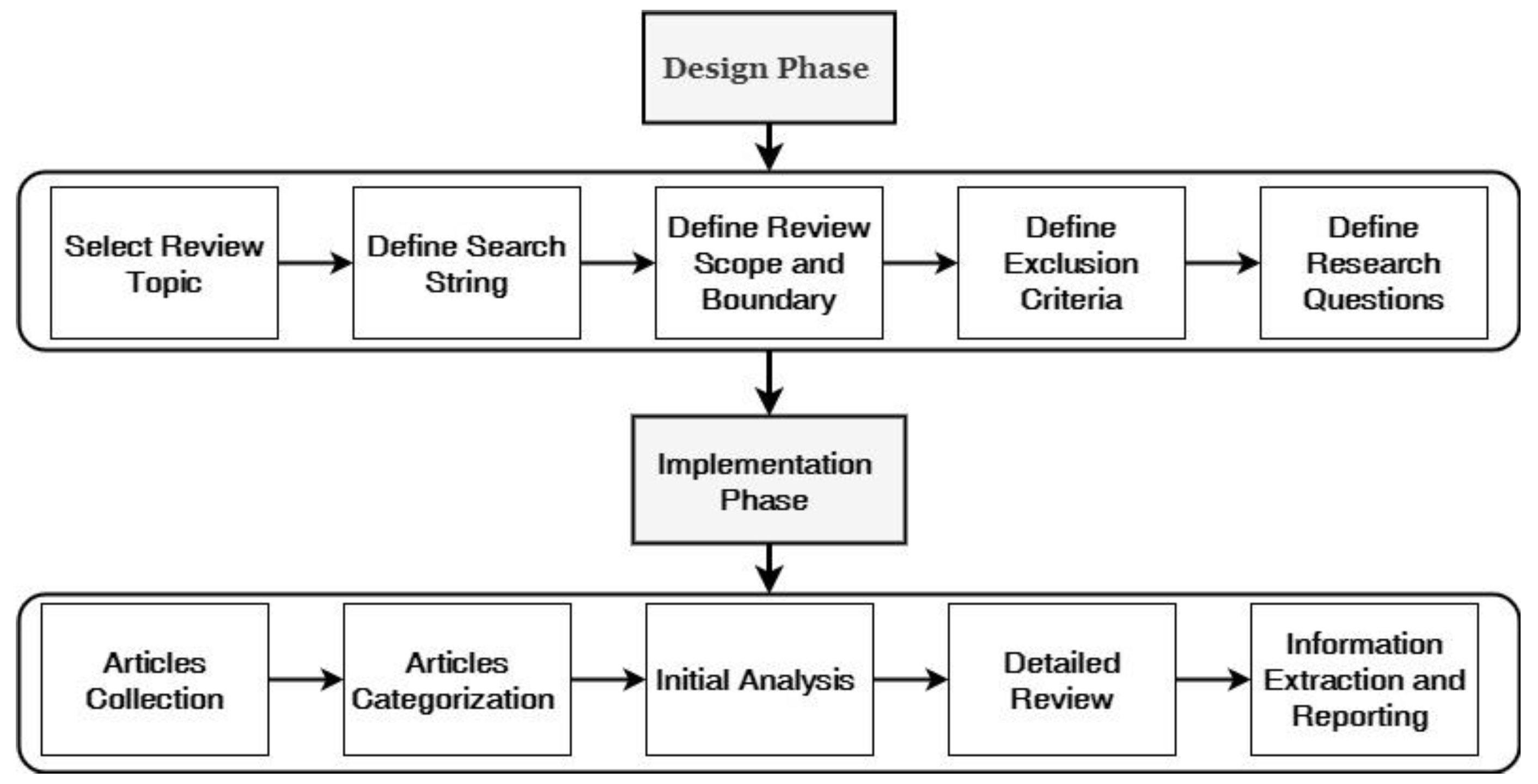
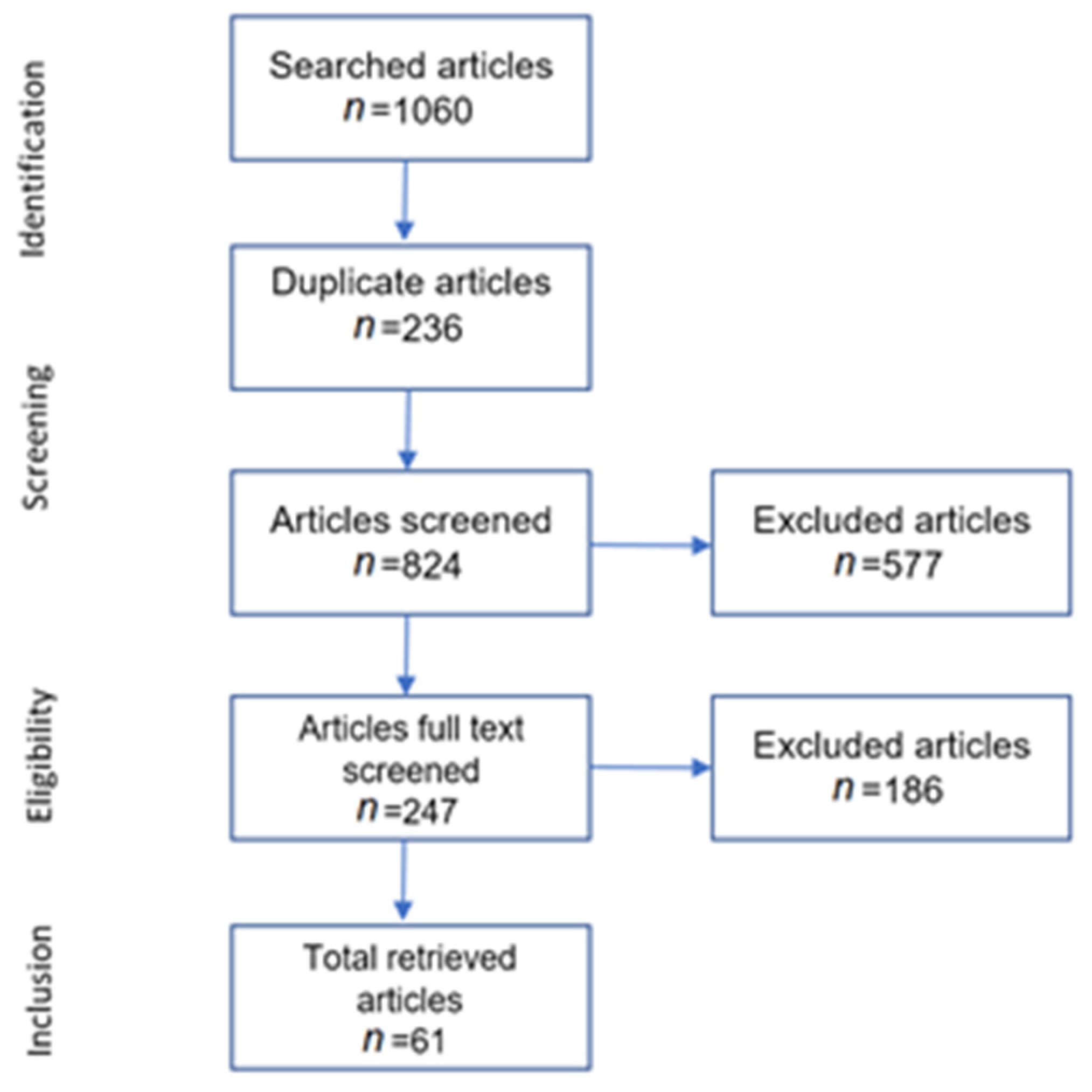
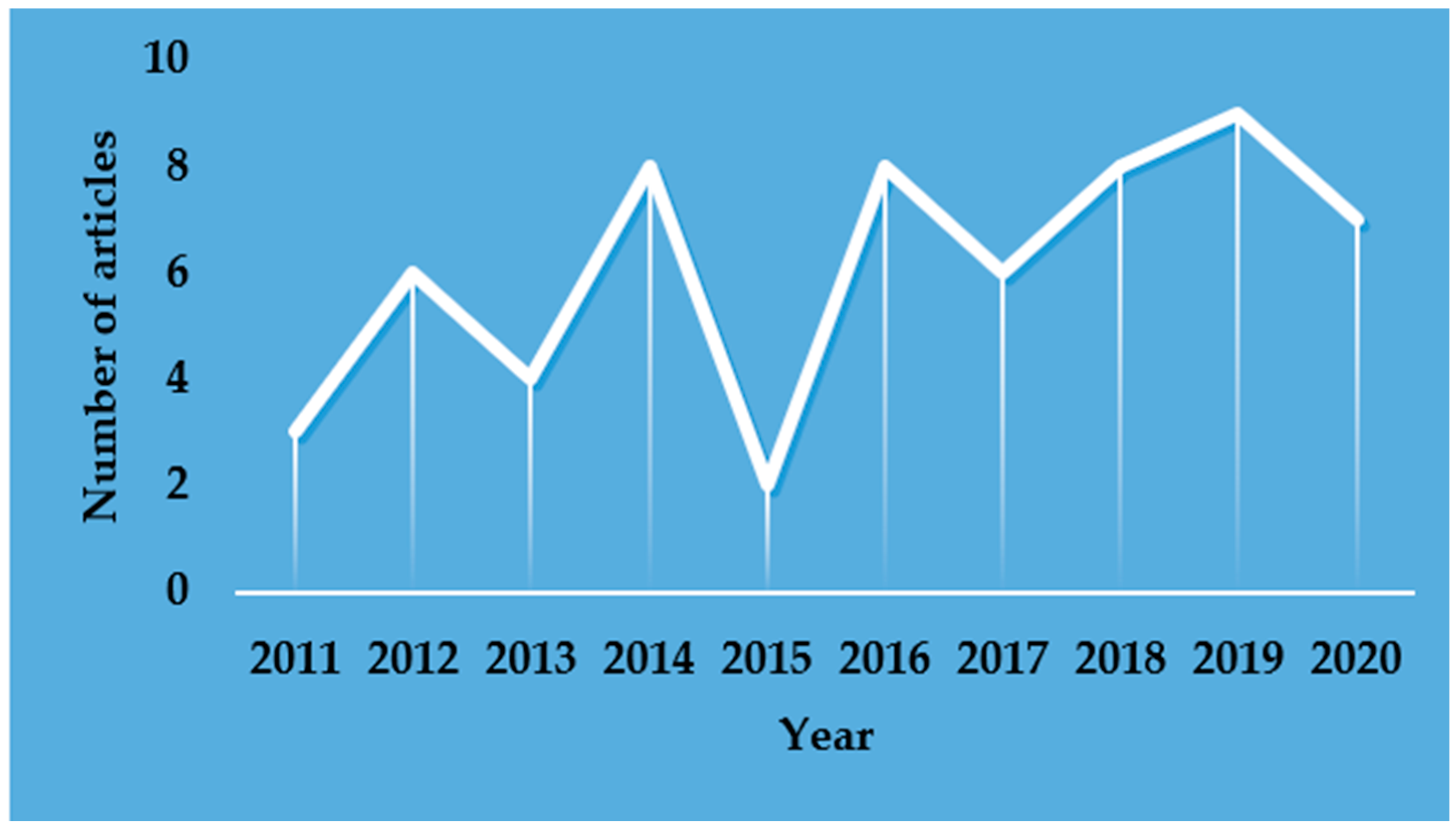
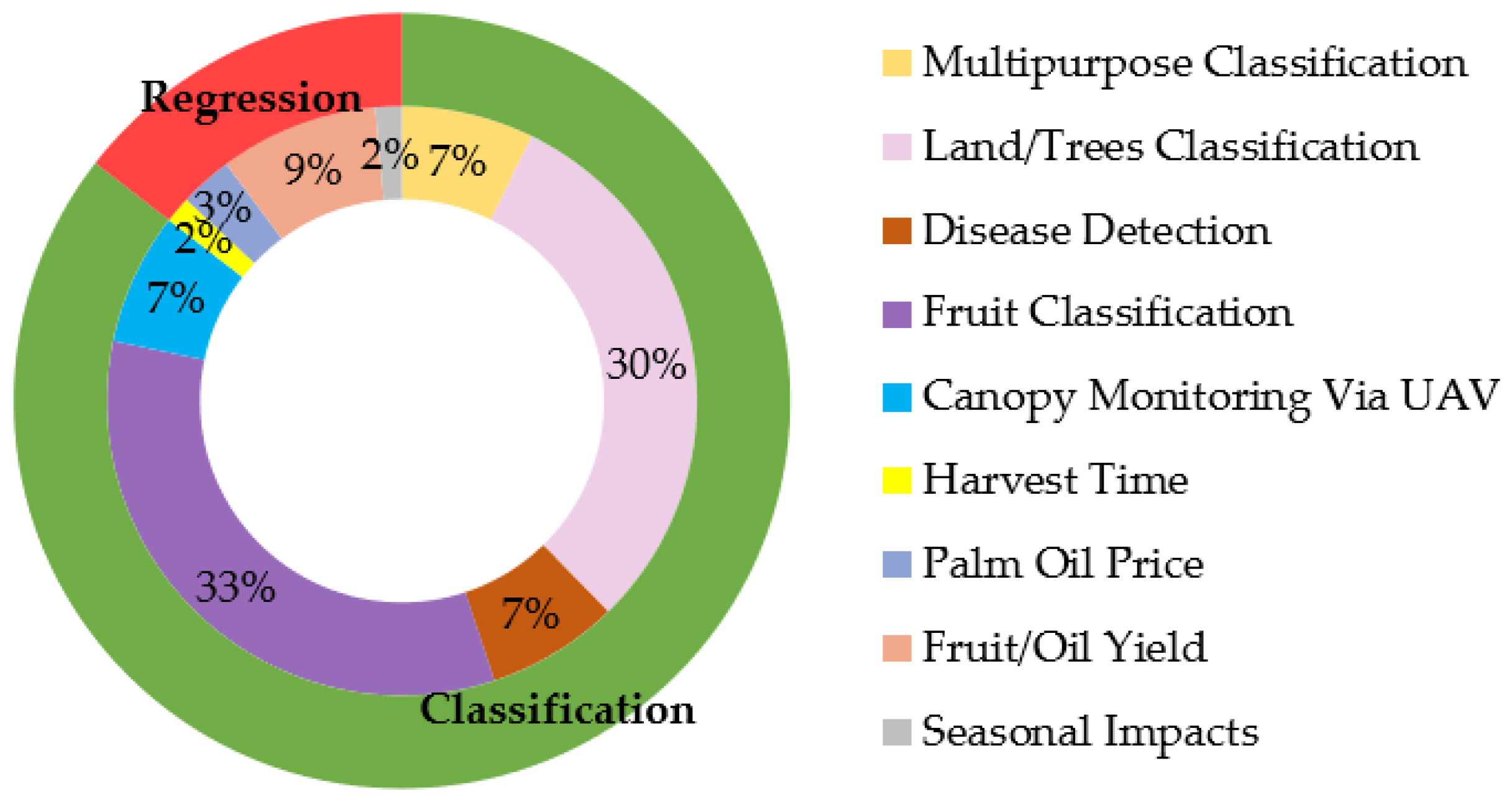
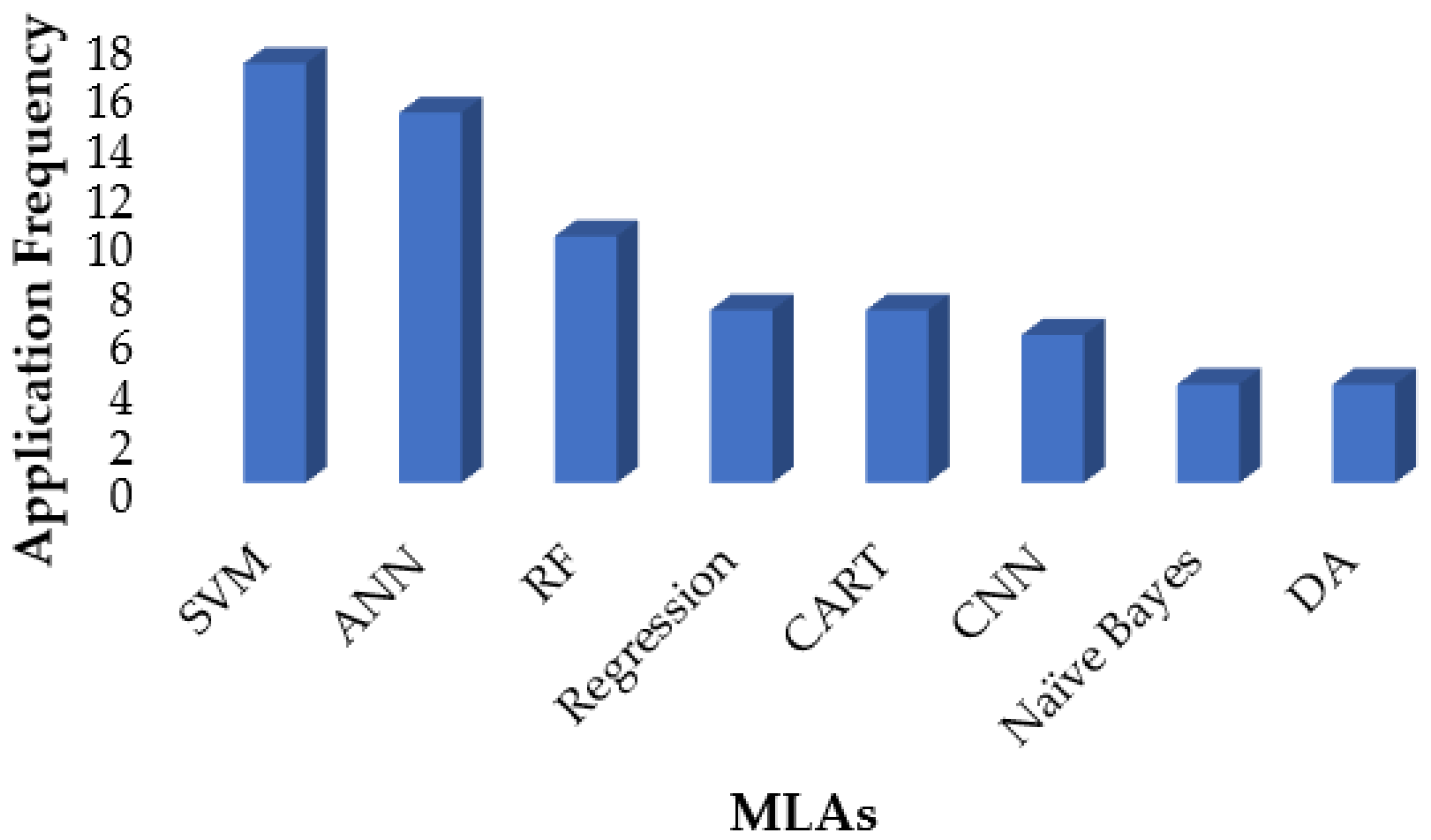
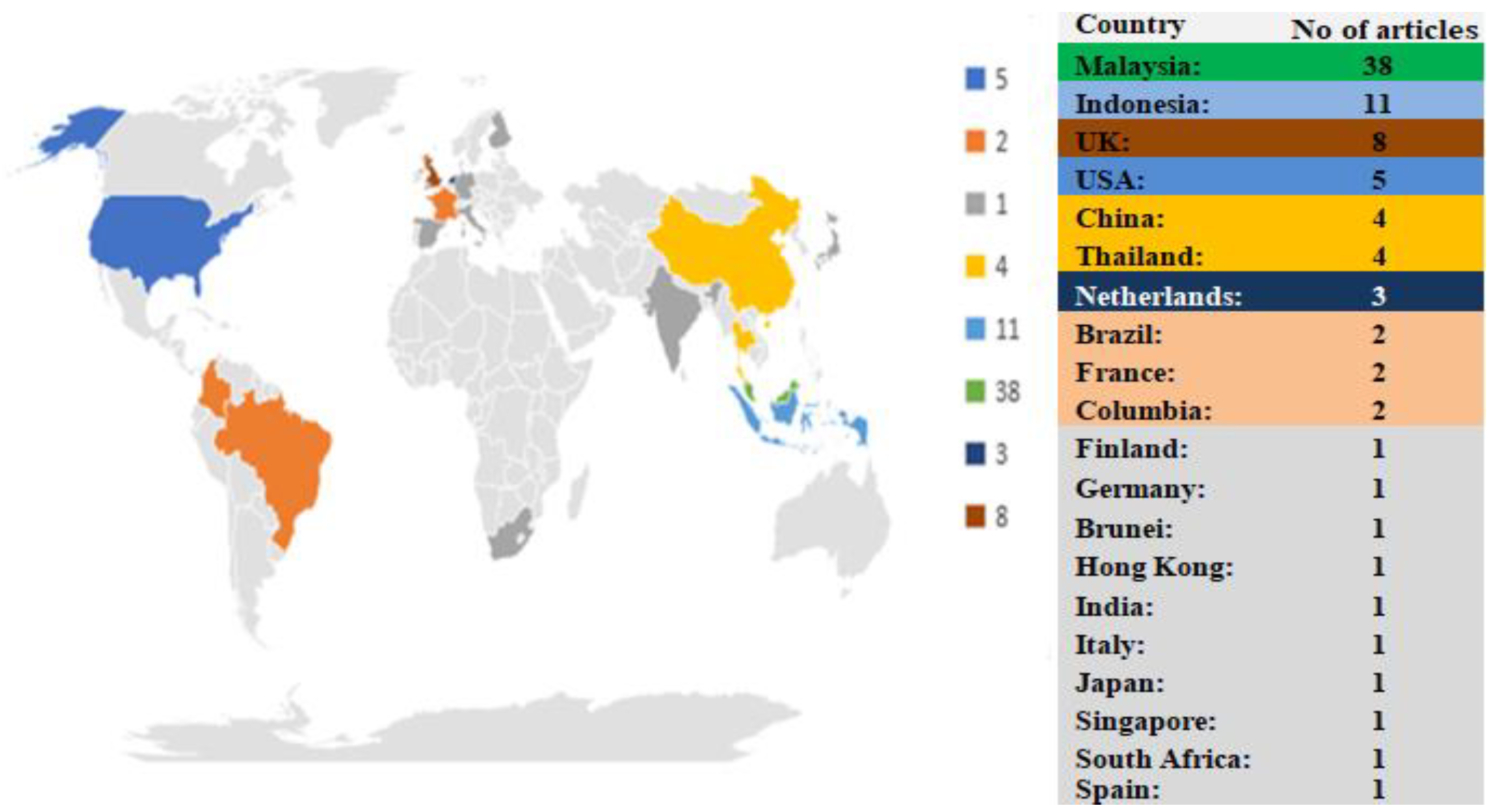

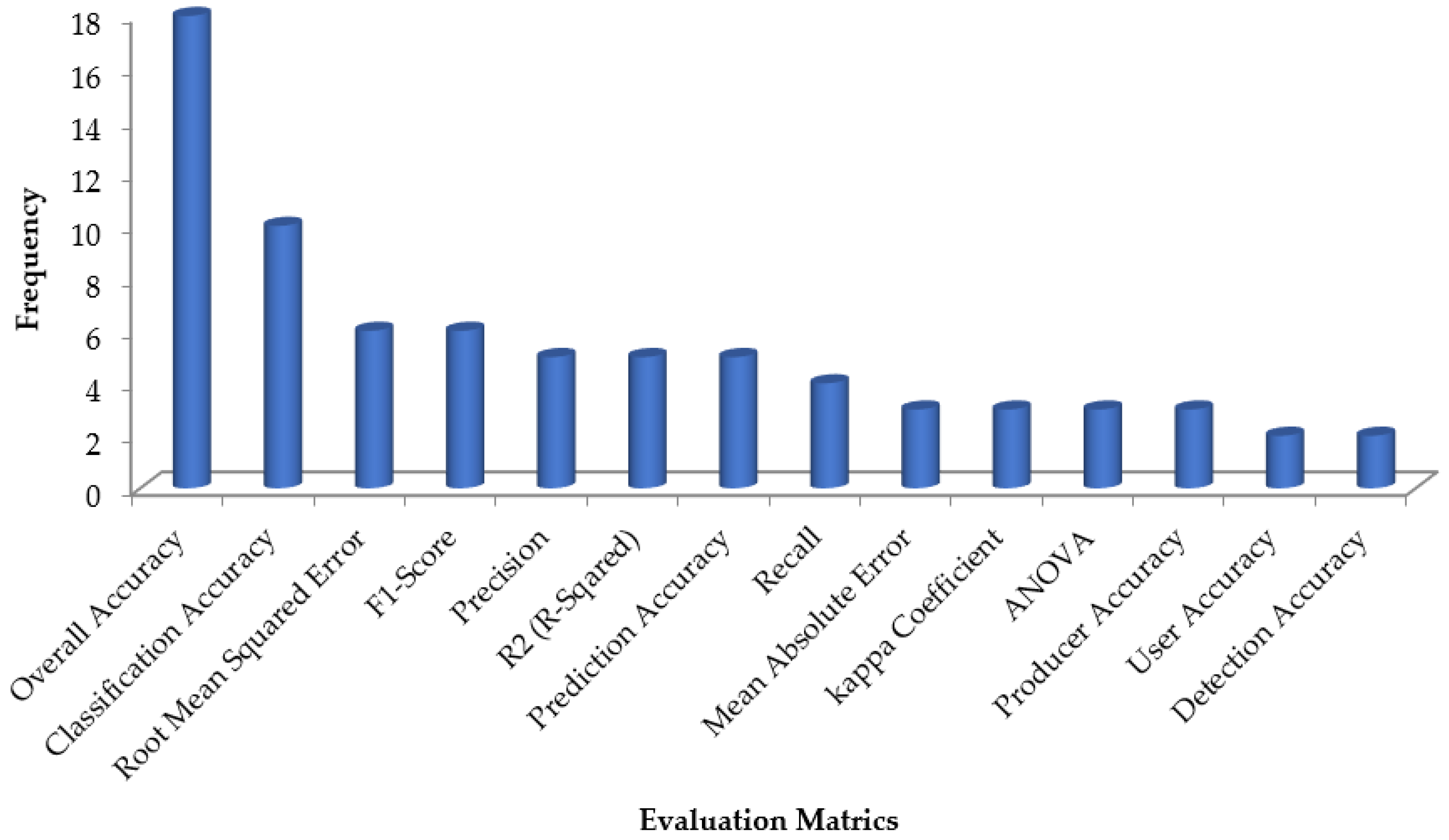
Publisher’s Note: MDPI stays neutral with regard to jurisdictional claims in published maps and institutional affiliations. |
© 2021 by the authors. Licensee MDPI, Basel, Switzerland. This article is an open access article distributed under the terms and conditions of the Creative Commons Attribution (CC BY) license (https://creativecommons.org/licenses/by/4.0/).
Share and Cite
Khan, N.; Kamaruddin, M.A.; Sheikh, U.U.; Yusup, Y.; Bakht, M.P. Oil Palm and Machine Learning: Reviewing One Decade of Ideas, Innovations, Applications, and Gaps. Agriculture 2021, 11, 832. https://doi.org/10.3390/agriculture11090832
Khan N, Kamaruddin MA, Sheikh UU, Yusup Y, Bakht MP. Oil Palm and Machine Learning: Reviewing One Decade of Ideas, Innovations, Applications, and Gaps. Agriculture. 2021; 11(9):832. https://doi.org/10.3390/agriculture11090832
Chicago/Turabian StyleKhan, Nuzhat, Mohamad Anuar Kamaruddin, Usman Ullah Sheikh, Yusri Yusup, and Muhammad Paend Bakht. 2021. "Oil Palm and Machine Learning: Reviewing One Decade of Ideas, Innovations, Applications, and Gaps" Agriculture 11, no. 9: 832. https://doi.org/10.3390/agriculture11090832
APA StyleKhan, N., Kamaruddin, M. A., Sheikh, U. U., Yusup, Y., & Bakht, M. P. (2021). Oil Palm and Machine Learning: Reviewing One Decade of Ideas, Innovations, Applications, and Gaps. Agriculture, 11(9), 832. https://doi.org/10.3390/agriculture11090832








